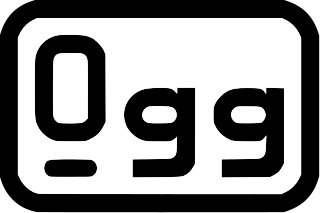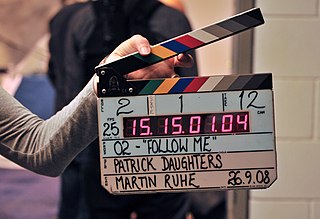Related Research Articles

Ogg is a free, open container format maintained by the Xiph.Org Foundation. The authors of the Ogg format state that it is unrestricted by software patents and is designed to provide for efficient streaming and manipulation of high-quality digital multimedia. Its name is derived from "ogging", jargon from the computer game Netrek.
In telecommunications and computer networking, a network packet is a formatted unit of data carried by a packet-switched network. A packet consists of control information and user data; the latter is also known as the payload. Control information provides data for delivering the payload. Typically, control information is found in packet headers and trailers.

Digital Visual Interface (DVI) is a video display interface developed by the Digital Display Working Group (DDWG). The digital interface is used to connect a video source, such as a video display controller, to a display device, such as a computer monitor. It was developed with the intention of creating an industry standard for the transfer of uncompressed digital video content.

SMPTE timecode is a set of cooperating standards to label individual frames of video or film with a timecode. The system is defined by the Society of Motion Picture and Television Engineers in the SMPTE 12M specification. SMPTE revised the standard in 2008, turning it into a two-part document: SMPTE 12M-1 and SMPTE 12M-2, including new explanations and clarifications.
AES3 is a standard for the exchange of digital audio signals between professional audio devices. An AES3 signal can carry two channels of pulse-code-modulated digital audio over several transmission media including balanced lines, unbalanced lines, and optical fiber.

D-1 or 4:2:2 Component Digital is an SMPTE digital recording video standard, introduced in 1986 through efforts by SMPTE engineering committees. It started as a Sony and Bosch – BTS product and was the first major professional digital video format. SMPTE standardized the format within ITU-R 601, also known as Rec. 601, which was derived from SMPTE 125M and EBU 3246-E standards.

Serial digital interface (SDI) is a family of digital video interfaces first standardized by SMPTE in 1989. For example, ITU-R BT.656 and SMPTE 259M define digital video interfaces used for broadcast-grade video. A related standard, known as high-definition serial digital interface (HD-SDI), is standardized in SMPTE 292M; this provides a nominal data rate of 1.485 Gbit/s.

Dolby Laboratories, Inc. is a British-American technology corporation specializing in audio noise reduction, audio encoding/compression, spatial audio, and HDR imaging. Dolby licenses its technologies to consumer electronics manufacturers.
CTA-708 is the standard for closed captioning for ATSC digital television (DTV) viewing in the United States and Canada. It was developed by the Consumer Electronics sector of the Electronic Industries Alliance, which became Consumer Technology Association.
AES47 is a standard which describes a method for transporting AES3 professional digital audio streams over Asynchronous Transfer Mode (ATM) networks.
Dolby Digital Plus, also known as Enhanced AC-3, is a digital audio compression scheme developed by Dolby Labs for the transport and storage of multi-channel digital audio. It is a successor to Dolby Digital (AC-3), and has a number of improvements over that codec, including support for a wider range of data rates, an increased channel count, and multi-program support, as well as additional tools (algorithms) for representing compressed data and counteracting artifacts. Whereas Dolby Digital (AC-3) supports up to five full-bandwidth audio channels at a maximum bitrate of 640 kbit/s, E-AC-3 supports up to 15 full-bandwidth audio channels at a maximum bitrate of 6.144 Mbit/s.
Serial Data Transport Interface is a way of transmitting data packets over a serial digital interface (SDI) datastream. This means that standard SDI infrastructure can be used.

IEEE Standard 1355-1995, IEC 14575, or ISO 14575 is a data communications standard for Heterogeneous Interconnect (HIC).

Asynchronous Serial Interface, or ASI, is a method of carrying an MPEG Transport Stream (MPEG-TS) over 75-ohm copper coaxial cable or optical fiber. It is popular in the television industry as a means of transporting broadcast programs from the studio to the final transmission equipment before it reaches viewers sitting at home.
In television technology, Error Detection and Handling (EDH) protocol is an optional but commonly used addition to the Standard Definition-Serial Digital Interface (SDI) standard. This protocol allows an SD-SDI receiver to verify that each field of video is received correctly.
SMPTE 292 is a digital video transmission line standard published by the Society of Motion Picture and Television Engineers (SMPTE). This technical standard is usually referred to as HD-SDI; it is part of a family of standards that define a serial digital interface based on a coaxial cable, intended to be used for transport of uncompressed digital video and audio in a television studio environment.
VLYNQ is a proprietary interface developed by Texas Instruments and used for broadband products, such as WLAN and modems, VOIP processors and audio and digital media processor chips. The chip implements a full-duplex serial communications interface that enables the extension of an internal bus segment to one or more external physical devices. The external devices are mapped into local, physical address space and appear as if they are on the internal bus. Multiple VLYNQ devices are daisy-chained, communication is peer-to-peer, host/peripheral. Data transferred over the VLYNQ interface is 8B/10B encoded and packetized.

The Display Serial Interface (DSI) is a specification by the Mobile Industry Processor Interface (MIPI) Alliance aimed at reducing the cost of display controllers in a mobile device. It is commonly targeted at LCD and similar display technologies. It defines a serial bus and a communication protocol between the host, the source of the image data, and the device which is the destination. The interface is closed source, which means that the specification of the interface is not open to the public. The maintenance of the interface is the responsibility of the MIPI Alliance. Only legal entities can be members. These members or the persons commissioned and approved by them have access to the specification in order to use it in their possible applications.
Uncompressed video is digital video that either has never been compressed or was generated by decompressing previously compressed digital video. It is commonly used by video cameras, video monitors, video recording devices, and in video processors that perform functions such as image resizing, image rotation, deinterlacing, and text and graphics overlay. It is conveyed over various types of baseband digital video interfaces, such as HDMI, DVI, DisplayPort and SDI. Standards also exist for the carriage of uncompressed video over computer networks.
ARINC 818: Avionics Digital Video Bus (ADVB) is a video interface and protocol standard developed for high bandwidth, low-latency, uncompressed digital video transmission in avionics systems. The standard, which was released in January 2007, has been advanced by ARINC and the aerospace community to meet the stringent needs of high performance digital video. The specification was updated and ARINC 818-2 was released in December 2013, adding a number of new features, including link rates up to 32X fibre channel rates, channel-bonding, switching, field sequential color, bi-directional control and data-only links.
References
- SMPTE: SMPTE 291M-1998: Ancillary Data Packet and Space Formatting
- SMPTE: ANSI/SMPTE 125M-1995: Component Video Signal 4:2:2; Bit-Parallel Digital Interface
- SMPTE: ANSI/SMPTE 334M-1995: Vertical Ancillary Data Mapping for Bit-Serial Interface
- SMPTE: RP168-2002: Definition of Vertical Interval Switching Point for Synchronous Video Switching
- SMPTE: SMPTE 299-1:2010: 24-Bit Digital Audio Format for SMPTE 292 Bit-Serial Interface
- SMPTE: SMPTE 299-2:2010: Extension of the 24-Bit Digital Audio Format to 32 Channels for 3 Gb/s Bit-Serial Interfaces
- SMPTE: Data Identification Word Assignments for Registered DIDs